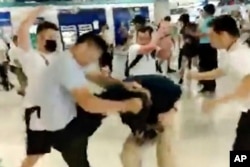Pro-democracy protests in Hong Kong moved into the city’s public transportation system Tuesday morning.
Subway passengers argued with hundreds of activists who blocked train doors. Subway service was delayed and partially suspended at some stations.
Reporters observed clashes between demonstrators and angry passengers who could not get out of subway cars.
Hong Kong’s Mass Transit Railway sent minibuses to replace trains affected by the demonstration. It also urged people to seek other methods of transportation.
Protesters’ demands expand
The aims of protesters have expanded since the Hong Kong government announced plans to amend the city’s extradition laws. Officials proposed the amendments in February.
Under the extradition bill, the government would send Hong Kong residents, who are charged with crimes, to mainland China for trial. Critics say the bill could threaten Hong Kong’s self-rule and its legal system.
In March, thousands of people protested in the former British colony against the proposal. The protests have continued for months, with demonstrators blocking traffic and clashing with police —sometimes violently.
The Chief Executive of Hong Kong, Carrie Lam, has faced strong criticism for seeming to carry out the will of mainland China over that of the people of Hong Kong.
Lam at first refused to set the extradition bill aside. But by June, she was forced to suspend the bill in an effort to satisfy protesters.
Then, on July 1, a large group of protesters forced their way into Hong Kong’s main legislative building. They broke glass doors, tore down pictures, painted on the walls and raised a former colonial flag.
The action took place on the 22nd anniversary of Hong Kong’s return to China. Since then, tensions have increased between the demonstrators and supporters of Lam and mainland China.
Earlier in July, a group of men in white shirts attacked and beat many people at the Yuen Long train station. The men wore white, apparently as a sign of opposition to protest leaders who wear black. Those who were attacked included people wearing black shirts.
Soon after the attack, police said they arrested six men. They accused some of having links to criminal gangs. The area around the station is said to be controlled by groups known as triads.
The attack shocked many in Hong Kong and led to accusations that the police were cooperating with gang members to target protesters. It also took place as demonstrations appeared to be calming down.
Since the bill was suspended, protesters have expanded their demands to include greater democratic reforms. The protesters also fear police are targeting them with force.
Reaction to the latest protest
Ken Chan took part in the subway demonstration Tuesday. He wanted transportation officials to explain why they reportedly failed to take action during the attack by white-shirted men.
“How could they let the triads in white attack people on the platform randomly, including the elderly and children in the train?” he said.
Lorraine Lee said the latest protest shows that the government has failed to deal with social, economic and political problems.
“That is why now Hong Kongers have no choice but to use different ‘creative’ approaches to remind people what is happening in Hong Kong,” she said.
The transportation blockage was only the latest in a series of protests in different parts of the city.
On Sunday, police fired tear gas and rubber bullets at protesters who were blocking streets. Protesters carried umbrellas, a sign of the protest movement.
Officials in Beijing have restated their support of Lam, but also expect her to deal with the unrest.
Chinese Foreign Ministry official Hua Chunying on Tuesday blamed foreigners for supporting the protests. She said the central government “opposes any foreign forces’ attempts to intervene in Hong Kong affairs.”
I’m Mario Ritter Jr.
Mario Ritter Jr. adapted this story for VOA Learning English based on reports from The Associated Press, Reuters and VOANews.com. George Grow was the editor.
We want to hear from you. Write to us in the Comments section, and visit our Facebook page.
_______________________________________________________________
Words in This Story
subway - n. a system of underground trains in a city
resident - n. someone who lives in a particular place
extradition – n. the action of sending someone accused of a crime to another area for trial
gang –n. a group of criminals who work together
platform –n. a flat area next to railroad tracks where people wait for the train
randomly –adv. without a plan or pattern
approach –n. a way of doing things
umbrella –n. a device used to protect from the sun or rain











